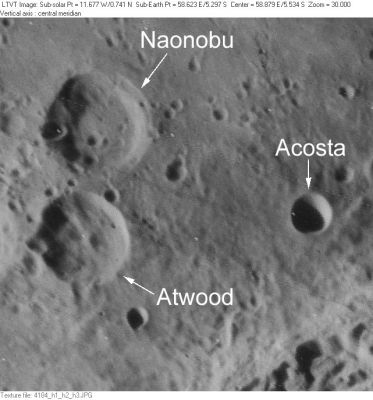Acosta
Contents
[hide]Acosta
(formerly Langrenus C)
|
Lat: 5.65°S, Long: 60.11°E, Diam: 12.73 km, Depth: 2.9 km, Rükl: 49 |
LO-IV-184H The other IAU-named features in this field are Atwood and Naonobu. The large crater whose rim protudes in the lower right is Langrenus.
Images
LPOD Photo Gallery Lunar Orbiter Images Apollo Images
- An oblique southward looking view of the bowl-shaped crater Acosta is seen near the left margin of Apollo 16's orbital ITEK-panoramic frame AS16-P-5205.
- Research: Danny Caes
Maps
(LAC zone 80B4) LAC map Geologic map LTO map
Description
Wikipedia
Additional Information
- IAU page: Acosta
- Data from Kurt Fisher crater depths
- Westfall, 2000: 2.9 km
- Viscardy, 1985: 1.75 km
Lunar Ellipse of Fire
Langrenus C (Acosta) is (or was?) number nine in the list of 12 localities in the Lunar Ellipse of Fire (see article from Farouk El-Baz in Sky and Telescope - June 1973).
Nomenclature
- Named for Cristobal Acosta (1515–1594), a Portuguese doctor and natural historian. He is considered a pioneer in the study of plants from the Orient, especially their use in pharmacology. Together with the apothecary Tomé Pires and the physician Garcia de Orta he is one of the major names of Indo-Portuguese medicine.
- The name Langrenus C was part of the original IAU nomenclature of Blagg and Müller (Catalog Entry 4688). It was attributed to Mädler.
- This replacement name for a formerly lettered crater was provisionally introduced on LTO-80B4 (June, 1975; for which it served as the chart title). It was approved in 1976 (IAU Transactions XVIB). - Jim Mosher
LPOD Articles
Bibliography
Named Features -- Prev: Catena Abulfeda -- Next: Adams
